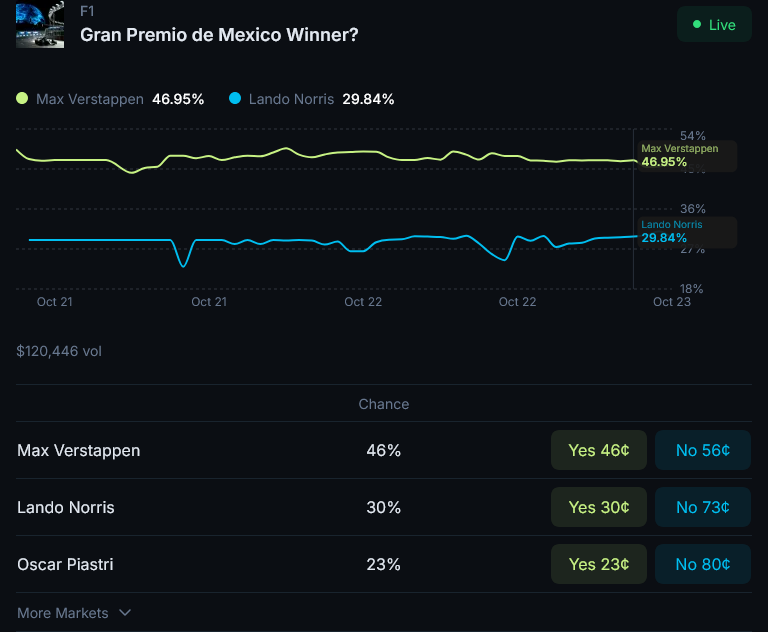The Jupiter prediction market on Solana, built in partnership with Kalshi, is launching its beta version, allowing users to bet on real-world events like Formula One races. Full rollout is expected in Q4 2025, enhancing on-chain asset variety and attracting more users to the decentralized exchange aggregator.
-
Jupiter’s prediction market beta launched on Wednesday, featuring initial betting on the Mexico Grand Prix winner.
-
It integrates Kalshi’s liquidity to enable secure, on-chain event betting for Solana users.
-
Early volume exceeded $120,000, with Max Verstappen favored at 46% odds, signaling strong institutional interest in prediction markets.
Discover how Jupiter’s new prediction market on Solana revolutionizes betting with Kalshi’s support. Explore beta features, growth stats, and Q4 launch—join the on-chain future today! (148 characters)
What is the Jupiter Prediction Market?
The Jupiter prediction market is a native offering from the Solana-based decentralized exchange aggregator Jupiter, designed to let users wager on real-world event outcomes directly on-chain. Launched in beta on Wednesday in partnership with Kalshi, it provides liquidity and focuses on expanding asset types beyond traditional trading. This initiative aims to broaden Jupiter’s ecosystem by incorporating prediction markets, which are projected to drive user growth and revenue for JUP token holders.
How Does Jupiter’s Partnership with Kalshi Enhance Prediction Markets?
Jupiter’s collaboration with Kalshi brings established liquidity provision to the Solana blockchain, enabling seamless betting on diverse events. Kalshi, a regulated prediction market platform, supplies the necessary infrastructure to ensure fair and secure transactions. According to Jupiter’s Q3 tokenholder report, the platform already boasts 8.4 million active users, a 5% increase from the prior quarter, underscoring its robust foundation for such expansions.
Prediction markets like this one allow participants to buy contracts representing yes or no outcomes for events, settling based on verified results. Kash Dhanda, Jupiter’s chief operating officer, emphasized in statements to industry observers that this partnership evolves on-chain assets, stating, “Prediction markets represent a powerful evolution in the types of assets available on-chain, and we’re thrilled to partner with Kalshi to bring them to Solana.” Early feedback will guide iterations, with limits starting at 100,000 global contracts and 1,000 per user to maintain stability during beta.
The sector’s growth is evident: weekly trading volumes across major platforms reached an all-time high of $2.03 billion for the week ended October 13, per data from Dune Analytics. Institutional interest has surged, as seen in Polymarket’s $9 billion valuation following a $2 billion investment from Intercontinental Exchange, the NYSE’s parent company, on October 7. Similarly, Kalshi secured $300 million in Series D funding, achieving a $5 billion valuation with backers including Sequoia Capital, Andreessen Horowitz, Paradigm, CapitalG, Coinbase Ventures, General Catalyst, and Spark Capital. These developments highlight prediction markets’ mainstream appeal, blending financial innovation with real-world forecasting.
For Jupiter, this means enhanced cross-product synergy, where prediction trading complements swaps and perpetuals, potentially boosting JUP token utility. Dhanda noted that as markets expand, “our reach, our cross-product synergy, and our revenue” will grow, benefiting token holders long-term. The beta’s inaugural market on the Mexico Grand Prix has already surpassed $120,000 in volume, with Max Verstappen leading at 46% odds and Lando Norris at 27%.
Frequently Asked Questions
What Events Can Users Bet on in Jupiter’s Prediction Market Beta?
In its beta phase, Jupiter’s prediction market offers betting on the upcoming Mexico Grand Prix winner in Formula One, with contracts limited to 100,000 globally and 1,000 per user. This initial market tests the platform’s mechanics, drawing from Kalshi’s expertise in event-based trading to ensure accurate outcomes and payouts.
When Will the Full Jupiter Prediction Market Launch on Solana?
The full launch of Jupiter’s prediction market is scheduled for the fourth quarter of 2025, following beta feedback integration. This timeline allows for adding more markets, increasing limits, and refining user experience on Solana, positioning it as a key feature for decentralized finance enthusiasts seeking diverse on-chain opportunities.
Key Takeaways
- Strategic Partnership: Jupiter teams with Kalshi for liquidity, marking a step toward mainstream prediction markets on Solana with beta access already live.
- User Growth Driver: With 8.4 million active users and rising volumes, the platform eyes expanded reach and JUP token benefits through event betting.
- Institutional Momentum: Backed by major investments like Polymarket’s $9 billion valuation, prediction markets signal a booming sector—act now to explore beta features.
Conclusion
The Jupiter prediction market represents a significant advancement for Solana’s decentralized ecosystem, integrating Kalshi’s liquidity to offer innovative event betting options. As volumes hit records like $2.03 billion weekly and institutions pour billions into platforms such as Polymarket and Kalshi, Jupiter’s Q4 2025 full launch promises to capture this momentum, driving user engagement and on-chain revenue. Stay ahead by monitoring beta developments and preparing for broader market access in the evolving world of crypto predictions.
The prediction market is expected to be fully launched sometime in the fourth quarter of the calendar year.
Solana-based decentralized exchange aggregator Jupiter is eyeing the fourth quarter for the full rollout of its new native predictions market offering that it’s building with Kalshi.
Jupiter on Wednesday announced it had just launched the beta version of its Jupiter Prediction Market. Kalshi will provide liquidity for Jupiter’s new offering, which allows users to bet on the outcome of events.
Why Jupiter entered the prediction markets race
Kash Dhanda, chief operating officer at Jupiter Exchange, told Cointelegraph that Jupiter’s goal is to give users a wide variety of offerings under a single platform, and that prediction markets would also allow them to attract more users.
“Prediction Markets represent a powerful evolution in the types of assets that are available on-chain, and we’re thrilled to partner with Kalshi to bring them to Solana,” Dhanda said.
Dhanda said prediction markets are growing at a rapid rate, which will lead to the platform acquiring new users.
As of the third quarter, Jupiter had 8.4 million active users, up 5% from the previous quarter, according to the Q3 tokenholder report.
“As our prediction markets grow, so does our reach, our cross-product synergy, and our revenue, all of which is long-term beneficial to JUP token holders,” Dhanda said when asked how the new prediction market will benefit tokenholders.
Dhanada said Jupiter will take user feedback to improve the product. Further, he said that the prediction market will be fully launched sometime in the fourth quarter.
“We’ll keep iterating on the product and increasing limits in line with feedback we receive – more markets will be added and we’ll be gearing up for a full launch in Q4 itself,” Dhanda said.
Prediction market in beta phase
The beta version currently only offers one market, which is about which Formula One driver will win the upcoming Mexico Grand Prix.
Global maximum contracts are set at 100,000 and individual positions are being restricted to 1,000 contracts.

The inaugural market has amassed $120,000 in volume since its launch on Wednesday. Source: Jupiter Exchange
Currently, the inaugural test market’s volume has exceeded the $100,000 milestone, with F1 driver Max Verstappen leading the pack, with nearly 46% of users predicting the Dutch-Belgian race car driver to win the event, with British race car driver Lando Norris coming second, with 27% odds of him winning the event.
Institutions’ appetite for prediction markets has increased
Polymarket and Kalshi, the two leading prediction market platforms, have seen their valuations soar as volumes on their respective platforms over the last few months.
Related: From South Park to Wall Street: Are prediction markets going mainstream?
On Oct. 7, Intercontinental Exchange, the parent company of the world’s largest stock exchange, NYSE, invested a sum of $2 billion into Polymarket, which valued the company at $9 billion.
Meanwhile, Kalshi raised $300 million in its Series D funding round. The firm was valued at $5 billion, and saw participation from Sequoia Capital, Andreessen Horowitz, Paradigm, CapitalG, Coinbase Ventures, General Catalyst and Spark Capital.
These investments come at a time when the prediction market industry, as a whole, is growing rapidly, with weekly trading volume across platforms hitting an all-time high, reaching $2.03 billion for the week ended Oct. 13, according to a Dune dashboard.
Magazine: Bitcoin to suffer if it can’t catch gold, XRP bulls back in the fight: Trade Secrets





